While preparing Part II of
The Story Behind the Lower East Side, I came across some old photographs of Chatham Square and couldn't resist checking out their locales…hence this post.
Here’s a photograph from Kenneth Dunshee’s
As You Pass By. This is reportedly a funeral procession heading up the Bowery through Chatham Square in 1869. Doyers Street would be in front of the tall building with the arched windows. Unbelievably,
two of
these buildings are recognizable today!
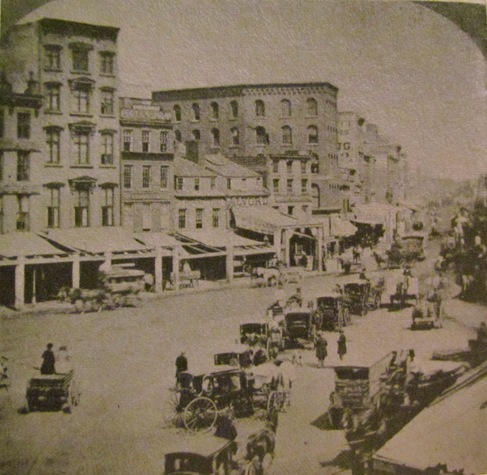
Can you see them?…
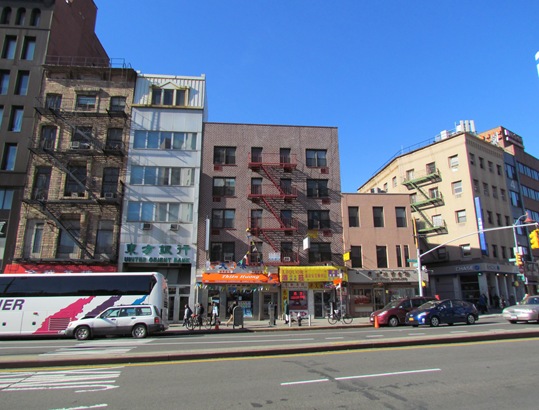
The windows have lost their pediments, and the facade has gotten a 1970s-style brick makeover, but the dimensions and arrangement of the windows leave no doubt that this is the same building.

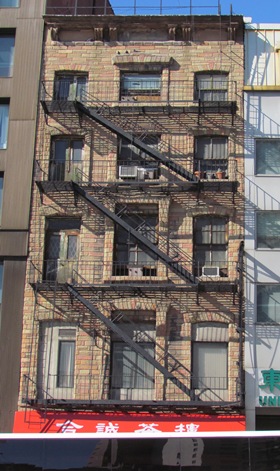
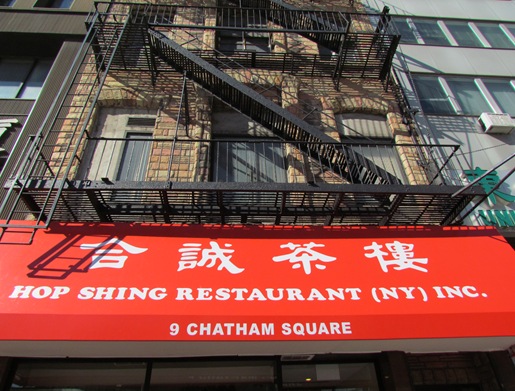
This building has a distinct 3-angled facade, “curving” to accommodate Doyers Street.
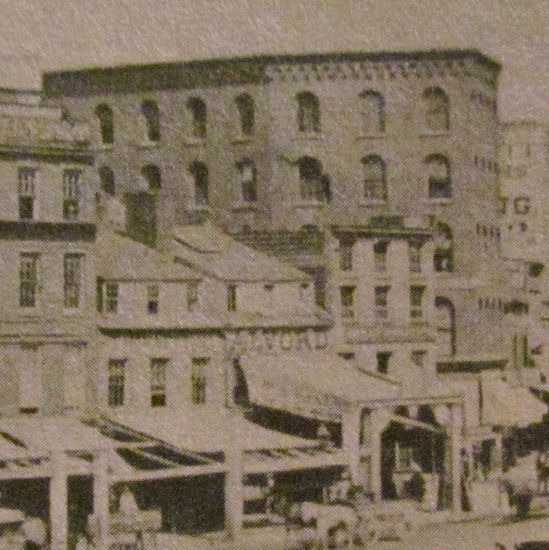
It has the same number of windows (three) across the middle section, and though the windows have lost their arches the corbelled cornice is still evident on the Bowery side. The next picture shows it more clearly…
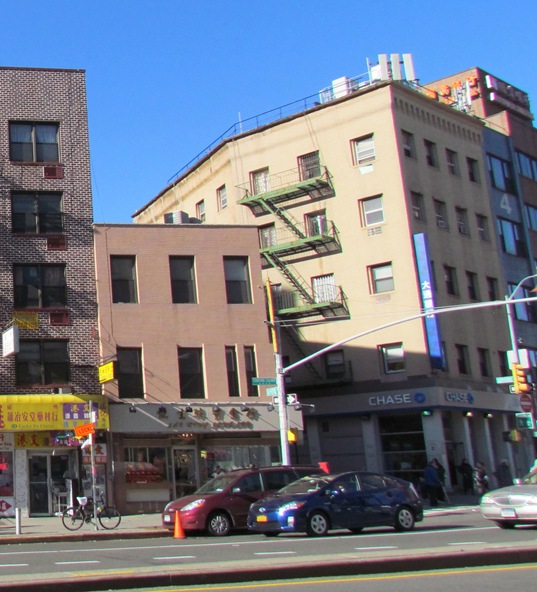

Different angle, same cornice detail…
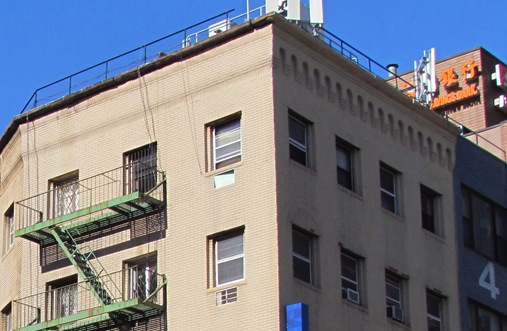
I couldn’t get the elevation of the photographer, but the next picture shows the street level today.

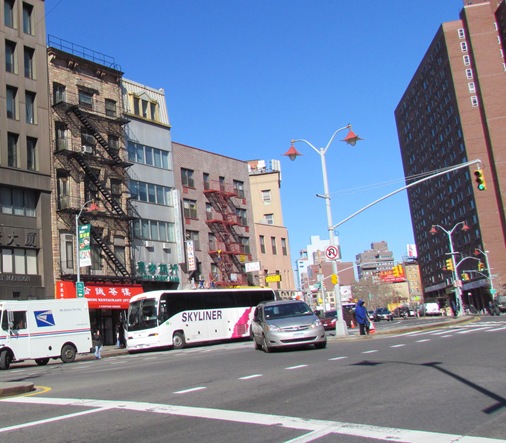 (added 3/5/2011)
(added 3/5/2011)
To give you an idea of the area in 1869, we were four years out from the Civil War, and the Draft Riots of
1865 1863 probably still loomed large in the city's consciousness (and conscience). The Draft Riots were a nearly week-long "event" that started out as a legitimate protest against the policy of permitting wealthy people to buy their way out of military service that, over the course of days, devolved into vicious gang assaults on African-Americans, wealthy abolitionists, and Republicans. That was in the city at large.
Chatham Square had been developing as a working class entertainment district since the depression of 1837. By 1869, the upper classes had long since moved uptown, and the Bowery Theater, once the entertainment focal point for the genteel enclaves at the Battery, St. John's Park (the entrance to the Holland Tunnel today), and Bond Street, had changed its format to appeal to working class.
The Bowery was, of course, a famous entertainment district. This entry from Allston T. Brown’s, A History of New York Stage from the First Performance in 1732 to 1901 (v.2), says what was going on at 7 Chatham Square (the building to the left of the first old building above) in 1854.
Gotham has a place like this in mind when it says, “‘Variety’ shows refused to specialize in any one popular entertainment form but mixed them all. Starting in 1865 Tony Pastor, a former clown and veteran concert saloon entertainer, ran one out of an old Bowery theater.” Tony Pastor would go on to invent vaudeville, a cleaned up, family-oriented version of the variety show. When you look at that old picture above, you’re looking at vaudeville and its pre-history.
Also important to note is that Chinatown was just about to start. Once again, Gotham reports, “In 1872 [3 years after the picture] Wo Kee, a former Hong Kong merchant, moved his general goods store from Oliver to Mott [just down Doyers], dropping the first anchor in the area that would soon be known as Chinatown.”
They're far from beautiful or important buildings today, but it's amazing to see how substantial and good looking they were back then.
(added 3/6/2011)
Shorpy's is a great website and had this great image of the area, circa 1905, when the 2nd and 3rd Avenue elevated trains merged in Chatham Square.
The 3-sided facade is beautiful with its arched lintels and its cornice, which now completely wraps around. In 1905 it was the Chinese Tuxedo Restaurant.
The other building to the left looks more like it did in 1869 than it does today, though in this picture it's gotten its fire escape. One thing that's new here since 1869 is the building with the mansard roof and the triangular pediment over the windows. It is only an echo of its former self...

span>
















Nice post, but one correction: the draft riots were in 1863, not 1865.
ReplyDeleteThanks, Stephanie--that was a sloppy mistake.
ReplyDeleteIs that a dirt road or cobblestones? It's hard to tell from the picture... And where did you find the picture? It's great.
ReplyDeleteThanks, I believe it is a dirt road. I'm not expert about street surfaces but perhaps because Chatham Square was so wide and expansive, it would have been inefficient to pave with belgian block or cobblestone. Chatham Square was the first clearing outside of the city that was on solid high ground, and the Boston stage (and others) terminated in Chatham Square. Perhaps the low risk of flooding made paving unnecessary.
ReplyDeleteNo mention of the Chatham Theater? Very important venue.
ReplyDeleteI'm happy about everything you bring it very interesting and helpful, thanks.Swertres Hearing Today
ReplyDeleteAmazing Article, Really useful information to all So, I hope you will share more information to be check and share here. BEST SUBLIMATION PRINTER
ReplyDeleteI have read your whole post it's very informative.STL Results Today
ReplyDeleteHaving read your article. I appreciate you are taking the time and the effort for putting this useful information together.
ReplyDelete